Substance addiction, which stems from the improper use of drugs or alcohol, is the classic model of physical addiction. It contrasts with behavioral addiction, a newly acknowledged form of addiction not centered on substance use. In a study published in January 2014 in the journal Drug and Alcohol Dependence, researchers from the U.S. and China compared the brain effects of one particular form of substance addiction—heroin addiction—to the brain effects of gambling disorder, the only officially recognized form of behavioral addiction in the U.S. These researchers concluded that the two conditions produce differing but overlapping brain changes.
Substance Use Disorders
Substance addiction is one of the two major components of an officially diagnosable condition called substance use disorder (which also includes serious, non-addicted substance abuse). People affected by this form of addiction experience long-term changes in their brains’ chemical status brought about by the repeated use of excessive amounts of alcohol or any one of a range of drugs or medications.
These changes occur because the brain receives enough exposure to alcohol, drugs or addictive medications to begin treating this exposure as the norm rather than the exception.
Symptoms Of Substance Addiction
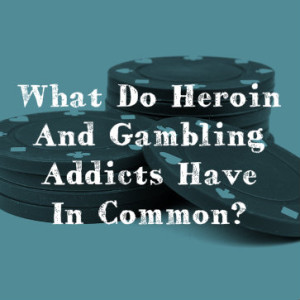 Strong and recurring urge to drink or use drugs
Strong and recurring urge to drink or use drugs- Corresponding inability to voluntarily limit substance intake
- Increasing tolerance to the effects of drugs or alcoho
- Withdrawal symptoms when the “normal” amount of alcohol or drugs is unavailable
- Destructive pattern of behavior focused primarily on substance use
Similarities Between Substance Addiction And Behavioral Addiction
Behavioral addiction produces a series of changes that mirror many key aspects of substance addiction. However, instead of stemming from excessive drug or alcohol intake, this form of addiction stems from excessive reliance on (or participation in) a specific activity.
- Strong and recurring urge to participate in a given behavior
- Inability to voluntarily limit that behavior
- Establishment of a destructive pattern of conduct focused on the behavior in question
Like substance addiction, behavioral addiction also creates long-term changes in the way the brain does its job. The American Psychiatric Association includes both substance addiction and behavioral addiction in a large grouping of conditions known collectively as substance-related and addictive disorders. There are a number of officially recognized substance-related disorders; however, as of 2014, gambling disorder (problem gambling, compulsive gambling, pathological gambling) is the only recognized form of addictive disorder.
Comparing The Brain Effects On Heroin Addiction Vs. Gambling Disorders
In the study published in Drug and Alcohol Dependence, researchers from the University of Southern California, the Chinese Academy of Sciences and China’s Guiyang Medical University conducted testing designed to compare the brain impairment of heroin addiction to the brain impairment of gambling disorder (identified in the study as pathological gambling).
Participants in this testing included 58 heroin addicts maintaining abstinence from drug use, 60 people diagnosed with gambling disorder and 60 generally healthy people unaffected by either heroin addiction or gambling disorder. Each of these participants took part in a test that assesses a critical form of short-term memory called working memory, as well as a separate test that assesses the ability to make decisions and control impulsive behaviors. The researchers compared the testing results of both the heroin addicts and the compulsive gamblers to the testing results of the healthy study participants.
They concluded that, compared to healthy people, heroin addicts experience a significant decline in their ability to use working memory, make decisions and control their actions. People affected by gambling disorder also experience problems making decisions and controlling their behaviors; however, they do not experience problems with their working memory. In addition, the researchers found that the brain impairments associated with heroin addiction grow worse over time. In contrast, the brain impairments associated with gambling disorder do not appear to grow worse or have a greater impact on people heavily addicted to gambling.
Behavioral Actions And Memory Problem Differences In Addiction
Based on their findings, the authors of the study published in Drug and Alcohol Dependence concluded that decision-making and impulse control problems appear to be central features of addiction, whether that addiction stems from a substance or a behavior. Memory problems, on the other hand, appear to be specific to substance addiction (or, at the least, heroin addiction). Further research will be needed to determine if other forms of behavioral addiction not officially recognized in the U.S. (such as sex addiction and Internet addiction) produce the same changes in brain function as gambling disorder.
Read More About The Importance Of Identifying Signs Of Substance Abuse In Bipolar Patients
30 Dec 2013
The History And Nasty Effects Of Krokodil
Would you swallow paint thinner or iodine? Would you inject yourself with lighter fluid or gasoline? Of course not. But desperate addicts living in impoverished areas of the world have turned to a drug that is made up of these kinds of toxic ingredients. The drug is known as Krokodil and it is a deadly substance.
The History Of Krokodil
Krokodil first appeared in the early 20th Century when it held a Swiss patent and was sold under the name Permonid. It is a derivative of morphine, but is 8-10 times stronger than morphine. Because of this, the drug also has a long history of non-medical use.
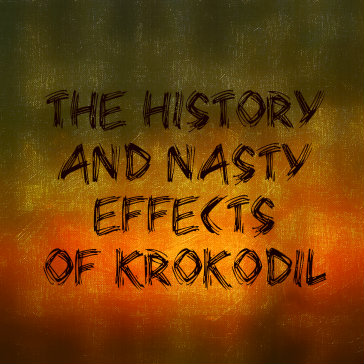 More recently, the drug resurfaced in poor areas of Russia around 2002 where it was seen as a cheap substitute for heroin. Krokodil is a concoction of codeine and any number of harsh chemicals which might be found around the house or in the garage. It has been cheap to make because until not long ago codeine was sold over-the-counter in Russia.
More recently, the drug resurfaced in poor areas of Russia around 2002 where it was seen as a cheap substitute for heroin. Krokodil is a concoction of codeine and any number of harsh chemicals which might be found around the house or in the garage. It has been cheap to make because until not long ago codeine was sold over-the-counter in Russia.
From 2002-2010 use of Krokodil spread across Russia, dragging what is guessed to be several million addicts in its wake. Exact figures on the numbers of users are hard to come by since the drug is essentially a form of suicide. Many users die within two years of starting to inject Krokodil. Why would people take such a scary drug? Because it is three times cheaper than heroin and 10 times stronger than codeine.
Krokodil did not remain in Russia. It is believed to have spread across Europe, taking hold in poor, mostly rural regions. It is now thought that Krokodil has crossed the ocean to Central or perhaps North America. There was a highly publicized report of a young girl who showed up in a hospital in Mexico City with what doctors thought to be a severe STD. Instead, it turned out that the girl had been injecting Krokodil into her genital area for a period of months.
Nasty Effects Of Krokodil On The Body
Krokodil is gruesome in that the drug destroys the user’s body from within. The drug causes blood vessels to break open and nearby tissue to die. Like the corrosive agents used to make the drug, lesions eat away a person’s flesh right down to the bone. It is called Krokodil because at the site where the person injects themselves with the drug the skin takes on a toughened, scale-like appearance. It gets a foothold among groups where heroin is too expensive. In the U.S. evidence shows a similar trend with many turning away from expensive prescription drugs in favor of far less costly street heroin.
Krokodil In The U.S.?
There have been unsubstantiated reports of Krokodil’s presence here in the United States, but so far no reports have been verified. Bringing a sample into a reputable lab is all that would be needed to determine that the drug has indeed come to America. Experts suggest that there is really no reason for Krokodil to find a home in this country.
Drug enforcement agents, addiction specialists and others say that the fact that Americans can afford less immediately lethal street drugs is reason enough to forego Krokodil. Though Krokodil, like methamphetamine, is a drug made as a home-brew, it is still hard to find, so why would drug users go looking for it? Lastly, Krokodil’s high is dependent on codeine – a substance that is far more controlled in this country than in other parts of the world.
So while the drug has definitely been traveling around the globe in recent years, it does not appear to have landed here as of yet. Still, the hopelessness that would drive a person to use such a frighteningly destructive drug is enough to warrant concern here at home and around the world.
Read More About Reported Cases Of Krokodil Use In The U.S.
Prescription painkiller abuse has grown large enough to gain the attention of pharmaceutical companies, doctors, addiction experts, and even the federal government. There are things which can be done to try and halt the abuse of prescription medications. However, those in the know say that when access to opioids is shut down, we can expect substance abusers to move on to heroin.
Made from a synthetic form of opium, opioids are heavy-duty pain relievers like Oxycodone (Percocet), Hydrocodone (Vicodin), OxyContin (a longer-lasting form of Oxycodone) and codeine. Hydrocodone and Oxycodone are usually mixed with aspirin or acetaminophen to produce longer-lasting pain relief.
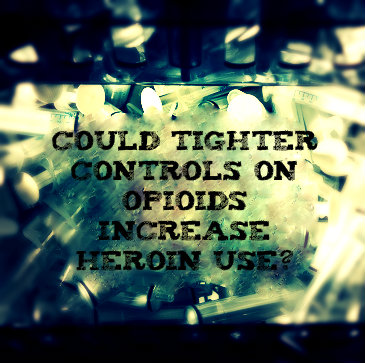 Opioids – Number One Prescribed Medication – Problem In The U.S.
Opioids – Number One Prescribed Medication – Problem In The U.S.
Opioids are the number one prescribed medication in the nation and are responsible for the vast majority of drug-related injuries and fatal overdoses, partly because people view them as safer than street drugs. Their wide availability means more drugs are in the hands of abusers.
Most opioid addicts started with a doctor’s prescription for a legitimate need. People who take more pills for a longer period than was prescribed can easily become addicted. Young people who use them recreationally can also quickly form a habit.
Thomas McClellan, the former Deputy Director for the White House Office of National Drug Control Policy, says if we can address these three issues the problem could be controlled:
3 Opioid Issues
- Over-Prescribing – Doctors want to control pain because it promotes healing and fosters a strong doctor-patient bond. Banning opioids outright will not work, but perhaps changing the standards of care which guide prescribing could.
- Insufficient Monitoring – Efforts are underway in most states to establish state-level monitoring programs. Under these programs every doctor who prescribes, patient who picks up and pharmacy that fills a controlled drug prescription will go on record. This should help reduce over-prescribing by doctors and keep patients from going from doctor to doctor in search of prescriptions.
- Patient Misuse – The Federal Drug Administration would like to see Hydrocodone reclassified to Schedule II so that it would have more oversight and be less accessible to patients. Under Schedule II constraints such as limiting automatic refills could help to reign in misuse.
How Tightly Controlling Opioids Could Increase Heroin Use
Would these measures stop painkiller abuse? Perhaps. But even if we succeed, experts predict that drug use will simply shift to another opiate: heroin.
Opioids are synthetic opiates (forms of opium) while heroin is a non-synthetic form. In other words, the drugs are somewhat related and produce similar results. Heroin costs about one half as much as synthetic opioids. So if opioids become more expensive and harder to get, experts predict that users will just switch to heroin.
Communities need to be ready for the shift that will most likely happen as a result of opioid crackdowns. The next question will be how to handle the heroin crisis.
If you or a love one needs help finding a drug rehab facility contact an Elements Recovery Advisor now! 855-763-6488
A new drug that has devastating consequences for its users may have finally been confirmed to have made it into the U.S. The drug is called Krokodil, and it first appeared in Russia as a cheap, homemade substitute for heroin. The name, which means crocodile in Russian, refers to the scaly sores that appear almost immediately after using this drug. The sores begin under the skin and can be so bad that the drug has been described as flesh-eating. The result is horrific and can lead to scarring, amputation, and even death.
Krokodil Beginnings In Russia
 Homemade injectable opioid drugs are nothing new in Russia. Resourceful people there have been creating and using their own drugs to get high for decades. In the 1990s, the heroin trade from Afghanistan increased and drug users did not need to make their own substitutes. Heroin addiction became a serious and widespread problem in the country.
Homemade injectable opioid drugs are nothing new in Russia. Resourceful people there have been creating and using their own drugs to get high for decades. In the 1990s, the heroin trade from Afghanistan increased and drug users did not need to make their own substitutes. Heroin addiction became a serious and widespread problem in the country.
Over the last few years, the Russian government has targeted illegal opium sales to try to solve the problem of heroin addiction. As sources of heroin dwindled and the product became more expensive, the practice of making heroin substitutes at home came back into favor. Krokodil is easily made from codeine, a prescription opioid, and other household chemicals.
Krokodil gives the user a high similar to heroin, but with even worse side effects. The green and black colored sores and ulcers begin to appear soon after the first use, and get worse as use of the drug continues. The drug, with the chemical name desmorphine, as well as the other chemicals that go into making it, tend to clump up and stay inside blood vessels all over the body. The clumps lead to infections and sores that spread and worsen.
Disputed Krokodil Cases In The U.S.
Experts in the field of illegal drugs have long feared that Krokodil would eventually show up in the U.S. Several disputed cases have been reported, including a doctor in the Chicago area who is convinced he treated two young women with the sores caused by Krokodil use. Cases in California and other states were also unconfirmed.
Reputable Case Of Krokodil Use In The U.S.
Now, it would seem that the worst fears of some have been vindicated. Two doctors working at St. Mary’s Health Center outside of St. Louis, Missouri, have published their findings from treating a victim of Krokodil use. They treated the 30-year-old man in December 2012. He had sores all over his legs. His skin was rotting away in places, and he had lost a finger on one hand to the infection. He told the doctors that he had been injecting himself with a synthetic heroin substitute that he made using codeine, gasoline, and other household chemicals. The admission, along with the sores, made a strong case that the doctors did treat a young man who had been using this scary new form of heroin.
Krokodile – Possible Future U.S. Epidemic?
If the doctors are right and Krokodil is now being used in the U.S., the implications are very serious. If drug users addicted to heroin and other opioids learn how to make this drug and can do so inexpensively, it could represent a new epidemic, much like what has been seen in Russia. The disfiguring effects of using Krokodil, as well as the addictive nature of the drug, mean that many people will suffer, and even die from using it. The Drug Enforcement Agency has yet to confirm the presence of Krokodil in the U.S., but with reports coming in from emergency rooms across the country, that confirmation does not seem to be far off.
Read More About Krokodil Claiming U.S. Victims
News accounts of the party drug known as “molly” seem to have been replaced recently with reports of a much more frightening drug called krokodil. Health officials are now concerned that the synthetic drug, which is said to deliver a heroin-like high, has made its way into the United States. Physicians in Utah, Arizona, and, most recently, Illinois, have reported possible cases of krokodil use, putting drug addiction and health experts on alert.
Krokodil Facts
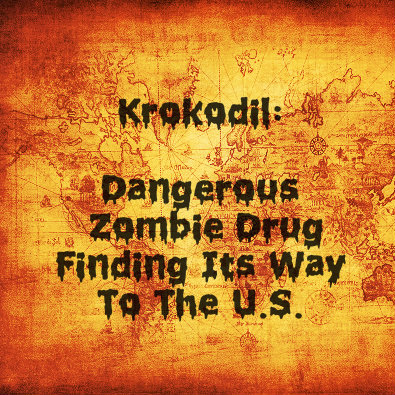 Krokodil is a homemade version of a drug called desomorphine, which was developed in the 1930s as a morphine alternative. However, researchers found that it was up to 10 times stronger than morphine, so its use was discontinued. Illicit drug users now re-create desomorphine by using a base made from codeine, a narcotic used to relieve pain and suppress coughs.
Krokodil is a homemade version of a drug called desomorphine, which was developed in the 1930s as a morphine alternative. However, researchers found that it was up to 10 times stronger than morphine, so its use was discontinued. Illicit drug users now re-create desomorphine by using a base made from codeine, a narcotic used to relieve pain and suppress coughs.
The drug, which Time has called a “dirty cousin of morphine,” also contains a dangerous mix of alcohol, paint thinner, gasoline and lighter fluid. The mixture includes red phosphorus as well, a substance used in the striking pads of matchboxes. Iodine is another ingredient — one that often leaves addicts enveloped in a tell-tale heavy iodine odor that, as one Russian physician noted, can’t be washed out of clothing.
Krokodil can be easily concocted at home in about 30 minutes. Users inject krokodil wherever they find available veins on their body, from their head to their feet. Injecting the drug delivers a high quickly — in as little as five minutes. This is in contrast to the one to two hours it can take to get high from drugs in pill or capsule form.
This dangerous substance delivers a more potent high than heroin. However, the euphoric feeling doesn’t last as long, at anywhere from 90 minutes to two hours. Addiction occurs quickly, catapulting users into a never-ending cycle that moves from cooking the drug to getting high to cooking the next batch. Users interviewed for news accounts have reported going for days without sleep as they binged on krokodil.
Krokodil Effects
Anyone who has seen the sensational-sounding online headlines about this drug addiction may have written them off as attempts by websites to generate traffic: “Zombie apocalypse drug reaches U.S.” or “Krokodil –The drug that eats junkies.” However, headlines like these are not exaggerations. The drug gets its name from its effect on the skin and underlying tissue. It’s believed the damage is caused not by the psychoactive ingredient desomorphine, but rather the caustic substances used in the concoction. These chemicals destroy blood vessels and tissue. Unsanitary drug cooking and injection practices also likely play a role in the destruction.
After krokodil is injected, blood vessels burst and tissue surrounding the injection site dies. As a result, the skin takes on a greenish, scaly appearance that mimics that of a crocodile, or krokodil in Russian. The process leads to open, festering wounds and infections as the skin rots from the inside out, eventually causing gangrene. Those with an addiction to krokodil can be left with dead skin that peels away to reveal tissue and bone underneath. Many users experience blood poisoning. The damage addicts suffer typically requires intensive wound care or skin grafts. Amputations are common.
Over time, the drug’s acidity also dissolves porous bone, especially in the jawbone and teeth. The effect has been compared to “meth mouth,” which is the unsightly rotting of the gums and teeth often seen in methamphetamine addicts. Chronic krokodil abusers frequently lose their teeth.
The average life expectancy of a krokodil addict is estimated to be very short at only two to three years. However, even those who are able to overcome the addiction are left with lasting and devastating physical effects. Krokodil causes brain damage in chronic users, leaving them with speech impediments and impaired motor skills, often in the form of jerky movements. In fact, the disjointed movements combined with addicts’ skin and tissue injuries have caused some to deem krokodil the “zombie” drug.
Krokodil In The U.S.
According to a report published in the Journal of Addictive Diseases, this homemade drug is believed to have first been used in Russia in 2003. For years, its use was confined largely to Russia and the surrounding countries that had been part of the Soviet Union. Experts estimate about 100,000 Russians have become addicted to krokodil and other illicit homemade drugs. By 2011, krokodil began moving into Germany and Norway. The ingredients are widely available, and users freely circulate recipes that make it easy to create batches on a home stove. It also costs a fraction of what users pay for heroin.
Currently, the U.S. incidents are being classified as possible cases; although the physical symptoms appear to be consistent with krokodil use, drug addiction experts have not been able to obtain samples of the drug, nor have they been able to get blood or urine samples that might confirm its use. Obtaining positive samples from addicts may be challenging because the body metabolizes the drug so quickly.
Krokodil Treatment
Because of the very serious side effects, treatment must start as soon as possible. Treating this addiction is a complex process, requiring a joint effort by physicians and addiction professionals. The obvious physical symptoms may require emergency care, making hospitalization necessary. As medical staff members try to stem the physical damage, a skilled addictions team will need to address the severe withdrawal symptoms.
Although the drug mimics the euphoric high of heroin, there are differences regarding withdrawal. Heroin’s physical withdrawal symptoms last about a week, while krokodil’s can draw out for as long as a month. Russian addiction experts say it causes such intense pain that it’s common to tranquilize patients during withdrawal. Addicts also experience seizures, fever, and vomiting.
Following withdrawal, a drug rehab team will start the addict on an intensive therapy program. Treatment will likely include extended inpatient rehab along with individual and group therapy. Long-term aftercare, including sober living, may also be part of the recovery plan. In addition, an addict might need physical or occupational therapy to address the physical aftermath of this addiction.
Krokodil addiction must be treated immediately by professional addiction treatment specialists. If you or someone you love is using this extremely dangerous substance, don’t wait to get help. Contact a drug addiction recovery center today.
Read More Russia’s Deadly Krokodil
A recent report from Olympia, WA, calls for a citywide conversation regarding the growing problem of heroin abuse plaguing the area—particularly drawing attention to the widespread issue of dirty needles. Heroin abuse is damaging in a host of more obvious ways—addiction, destroyed relationships, torched careers and the direct physical consequences—but one of the biggest issues comes from the use of unclean needles. This conversation isn’t a comfortable one for many citizens, but it’s a problem that will not go away, particularly with the epidemic-level prescription drug abuse gripping the nation.
Prescription Drugs: A Gateway To Heroin?
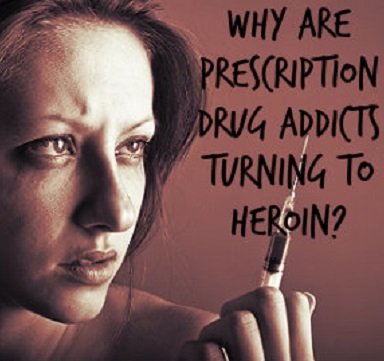 The prescription drug addiction crisis that America is facing has already been shown to have led users into heroin abuse. Understanding why requires some basic knowledge of the chemical similarity between the substances. The most effective painkillers are opioid drugs like oxycodone and hydrocodone (the active ingredients in OxyContin and Vicodin, respectively), substances derived from the opium poppy. This plant is the ultimate source of heroin, and the drugs are therefore effectively the same. Exceeding your doctor’s prescribed dosage heightens the narcotic effect of the substance, making it roughly comparable to taking a dose of heroin. This is why 12 million Americans used prescription painkillers non-medically in 2010 and why so many people become addicted and many of them overdose—but the supply isn’t always easy to come by.
The prescription drug addiction crisis that America is facing has already been shown to have led users into heroin abuse. Understanding why requires some basic knowledge of the chemical similarity between the substances. The most effective painkillers are opioid drugs like oxycodone and hydrocodone (the active ingredients in OxyContin and Vicodin, respectively), substances derived from the opium poppy. This plant is the ultimate source of heroin, and the drugs are therefore effectively the same. Exceeding your doctor’s prescribed dosage heightens the narcotic effect of the substance, making it roughly comparable to taking a dose of heroin. This is why 12 million Americans used prescription painkillers non-medically in 2010 and why so many people become addicted and many of them overdose—but the supply isn’t always easy to come by.
One of the unexpected downsides of cracking down on prescription drug abuse is that many people are left addicted to opiates but without the pills to satisfy their cravings. This problem is “solved” by many of the users by buying heroin — it’s easier to get and is cheaper than the medically legal versions prescribed by doctors.
Hidden Drug Problem
Olympia, WA, is experiencing an increase in heroin use. Previously, the heroin problem was primarily confined to grim alleyways in the inner city, but now—thanks in part to narcotic prescription medicines—it’s expanded into the suburbs, spreading across the city like a disease. While the obvious issues are the crimes associated with heroin abuse and the physical harm to the user, another immediate problem tied to increased heroin use is that of dirty needles littering the streets. The local paper, the “Olympian,” is calling for an open and frank discussion on the problem within the community.
Dirty Needles And Blood-Borne Viruses
Research from 2004 shows that one-fifth of HIV infections and the majority of hepatitis C infections were related to intravenous drug use, and one-quarter of America’s injecting drug users have HIV or AIDS. The reason is simple: with intravenous drug use, any case where two users share a needle represents a potential infection; the blood invariably remaining on the needle being plunged directly into the vein of the next user. In short, all needle-sharing is equivalent to unprotected sex. This is why needle-sharing is particularly ill-advised, but thinking realistically (particularly when accounting for the priorities of someone dependent on opiates) it’s clear that many users will take the risk to get their fix.
Needle Exchange Programs: Encouraging Addiction Or A Vital Service?
The problem with needle sharing is why needle exchange programs were created. The premise is simple: offer intravenous drug users a safe place to dispose of their used needles and offer them clean injecting equipment to reduce the risk of infections in the future. Olympia provides such a service and has for nearly 20 years. In 2012, about 950,000 dirty needles were collected and marginally fewer clean ones were distributed. The fact that the number of collections exceeds the number of distributions is a source of concern (the widespread discarded needles in locations like parks risk infecting children or non-using adults), but overall, the program undoubtedly reduces the numbers of blood-borne viruses.
However, critics argue that it isn’t right to distribute equipment to drug users who clearly have a problem, and that the programs merely allow them to continue on in addiction. This is an understandable criticism, but public health officials and those who operate the programs counter that the benefits of the programs outweigh the potential moral issues. Reducing the spread of HIV and hepatitis is a huge benefit, and it’s clear that the users aren’t only continuing to take heroin because they’ve been given free clean equipment; they are struggling with addiction and would continue using either way.
Harm Reduction As A Last Resort
It’s unreasonable to assume that every heroin user—or indeed every prescription drug user—will be able to quit effectively. Human history has repeatedly shown that not to be the case. This is why, in the most extreme cases, it’s better to focus on reducing harm as much as possible. The individual might be struggling to battle his demons and get clean, but does that mean we should stand by and do nothing while he risks HIV infection? It might make us feel like we live in a more harmonious world to pretend that these problems don’t exist, but it doesn’t improve the situation. If you turn a blind eye to the unnecessary suffering, you’d be fooling yourself to think it stopped happening.
See How Prescription Drug Abuse Is A Growing Problem On College Campuses – Click Here
My story of addiction and recovery is the story of a near miss and an incredibly lucky break. Therapists talk about resilience and protective factors (as opposed to risk factors)—well, I had a boatload of risk factors but somehow I was able to muster some reserves, survive and ultimately thrive.
My story begins when I woke up from a blackout and realized that I had been raped. I remember drinking the night before, but I don’t remember anything from about halfway through the night until the next morning. The other people at the party helped me piece it together—what they saw and heard plus what I felt and what it all added up to. I was 13 years old and was already drinking myself into blackouts. The boy who raped me said he didn’t remember it either. He was only 14.
Within a year I was raped again, this time by an adult—the father of the child for whom I babysat. He was drunk. He was driving me home from babysitting his infant daughter, and made a wrong turn. I knew what was coming and just braced myself for it. I never told anyone.

Stopping One Addiction And Dangerously Starting Several Others
I stopped drinking but I didn’t stop trying to drown. I smoked marijuana, ate Quaaludes, black beauties, and pink footballs; I snorted cocaine, and eventually snorted heroin. I dated a dealer, and did anything I was handed, no questions asked. It came to me one day, an epiphany of sorts: I realized that if I continued to live the way I had been living that I would die. I had stopped short of using needles, but snorting coke and heroin wasn’t getting me high anymore. I had to escalate again, or get clean, or face the reality that life as a heroin addict-garbage head was likely going to kill me.
A mental health professional had said to me that women with my history end up either dead or in prostitution. For a 15-year-old, this was a pretty heavy realization. I wanted to talk with my mom about it, but when I asked her to talk with me later that day, she said no. I pressed her, telling her that I needed her to listen to me. “No,” she said, “I can’t listen to you.”
Pain, Molestation And Addiction At A Young Age
So maybe my story doesn’t begin at age 13 in a blackout after all. If by age 15 my mom couldn’t tolerate listening to me, obviously a whole lot more was going on and had been for some time. I started drinking when I was 12. I wasn’t the only seventh-grader who was drinking, but I was likely the only one who was drinking to deal with flashbacks.
Backing up another year, things had happened that I still struggle to name. Rape is too simple and it conjures up the wrong set of images. Incest is too familial and can’t capture the way it feels when it is your teacher. Yes, my teacher, my sixth-grade teacher.
There aren’t words for what he did; there are sentences. He was a pedophile, and he groomed me for months, setting me up to be in a position where I wouldn’t say no and I wouldn’t tell anyone. He betrayed my trust and he took my childhood at age 11. I loved him and he said he loved me. It was truly confounding. It went on for months, my lies to my mom about where I went after school, my first lies ever to anyone.
It was Lolita, so I’m told—a novel that no matter how wonderfully written it may be, I have never been able to read it. At the end of the school year, he disappeared. Eventually I told a friend, and she told my mom. Police were called, school officials informed. I was interviewed, and then interviewed again by a special police “verifier” to determine whether I was making it all up. I wasn’t.
Choosing Life And Healing In Recovery Over A Life Of Pain And Addiction
After spending the next few years trying to not feel anything, and then choosing to live instead of die, recovery was a very long and difficult road. Not drinking or drugging was relatively easy. Figuring out what to do with all those feelings and how to get my needs met in healthy ways was the real recovery. It took years of therapy, and a passionate will to “be better”—to not only stop trying to kill myself, but to actually enjoy living.
For a while, pursuing some sort of healing was a full-time endeavor. I chased healing and recovery, stalked it, pursued it relentlessly. I was vulnerable to healers of every make and model, and spent money I shouldn’t have spent and time I didn’t have seeking healing.
While I learned a ton and all of it was useful at some level, I think the critical moments were back in my teens when I chose—consciously chose—to live and to live well. I had no idea how I would make that happen, but it was adolescent spunk and contrariness that fueled my strength. Mom won’t listen to me? I’ll show her. In fact, a decent amount of “I’ll show her” propelled me forward through the hardest times. During that critical and vulnerable time, the anger and the desire to show my mom that I would get through this without her help was probably the single biggest protective factor I had going for me.
Reconciliation With Self And Family
Mom and I are reconciled now. We rarely talk about what happened—it is still a sore subject for both of us. Her pain at failing to protect me from a predator is a wound from which she’s had to heal. The rough ride through my teens is something I’ve had to move past—not easy when I was invited to witness teenage years all over again, ringside, as my daughter grew up. Now she is 19 and more whole and healthy than I think I ever have been, and while I can’t take credit, at least I can say with some relief—my past did not infect her.
At some point in my 40s, I stopped chasing down healing. Not that I declared myself finished with that project, but more to the point I realized that no one is ever fully finished. I am back on a level playing field. The challenges that were tossed in my path when I was young no longer haunt me and I am truly happy with my life. I’ve been through a few dark tunnels, and who knows, maybe more will come my way. But for now, for today, I can feel all I feel and deal with whatever comes my way. Life isn’t perfect, but it is good enough.
Stories appear in the news on nearly a daily basis describing a trendy new drug, the explosion of a meth house, overdose deaths or some other tragic event due to drugs, alcohol and addiction. It can be hard to take away the real facts from these stories. To know what is really happening in the U.S. when it comes to drug and alcohol abuse, statistics and solid facts are helpful.
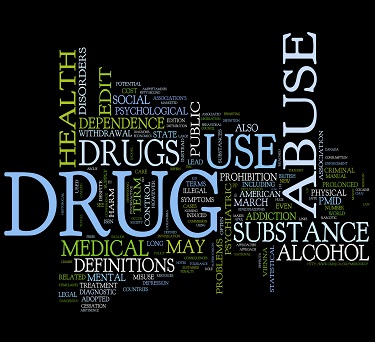 Every year the National Survey on Drug Use and Health (NSDUH) questions a random selection of close to 70,000 Americans. All participants are 12 years and older and the purpose of the survey is to estimate how many Americans are using various illicit drugs, prescription drugs, alcohol and tobacco, and how they are using them. To get accurate data in this way helps with the implementation of preventive programs and treatment offerings for substance abusers. The study is conducted every year so that trends can be established.
Every year the National Survey on Drug Use and Health (NSDUH) questions a random selection of close to 70,000 Americans. All participants are 12 years and older and the purpose of the survey is to estimate how many Americans are using various illicit drugs, prescription drugs, alcohol and tobacco, and how they are using them. To get accurate data in this way helps with the implementation of preventive programs and treatment offerings for substance abusers. The study is conducted every year so that trends can be established.
The most recent NSDUH provides data for 2012. The latest results of the survey give a picture of drug and alcohol use in the U.S. that some may find surprising. Trends in the use of specific drugs show which are decreasing and which are exploding in popularity. The results also show trends in the ages of drug users, the prevalence of binge drinking and attitudes toward smoking.
Binge Drinking On The Rise
Binge drinking is on the rise and is considered a type of substance abuse. The Centers for Disease Control and Prevention define binge drinking as having five or more drinks within a two-hour period for men, and four or more for women. This level and rate of drinking elevates a person’s blood-alcohol content to 0.08.
According to the NSDUH data, more than half of Americans are drinking. That represents over 130 million people. Of those, one quarter, or around 60 million people, binge drink. Not only does binge drinking have serious health consequences over the long term, it can also result in immediate problems, such as drunk driving and accidents.
Spike In Heroin Use
Methamphetamine, commonly called crystal meth, speed, or just meth, is a dangerous, destructive and highly addictive drug. Not only does the drug destroy lives through addiction and health problems, the way in which much of it is made has harmed or killed people. Meth is a drug that can be made with household chemicals and drugstore buys. For this reason, a decade ago, meth labs cropped up around the country and came with poisoning fumes and accidental explosions. The good news from the survey is that use of meth is decreasing. Nearly 731,000 people used meth in 2006, and for 2012 the number dropped to 440,000.
The bad news is that use of heroin is rapidly rising. Another very serious drug, heroin is extremely addictive and has the potential to cause an overdose on the first try. The number of Americans using heroin, according to NSDUH, doubled between 2007 and 2012, from 373,000 to 669,000.
Drug Use Among Baby Boomers Is Increasing
Drug use among the baby boomer generation is on the rise. Compared to a decade ago, the number of adults between the ages of 50 and 64 using drugs doubled. Among those aged 55 to 59, the rate tripled. Americans in this age group were young during the 1960s when drug use exploded. As they age, these people are still using drugs to some extent. They are using more than the generation before them ever did.
Having accurate information from the NSDUH is crucial in developing policies, substance abuse prevention plans and treatments for addicts and abusers. The survey information provides an accurate glimpse of what Americans were doing in 2012 and also how behaviors are changing. Some of the news was good: the number of teenagers smoking cigarettes has been cut in half over the last 10 years. Some news, though, like the explosion of heroin use, is less promising.


